Before there was Ryan Place’s Elizabeth Boulevard, with its forty-four “exclusive” homes along seven blocks, there was Chase Court, with its fourteen “exclusive” homes along just one block.
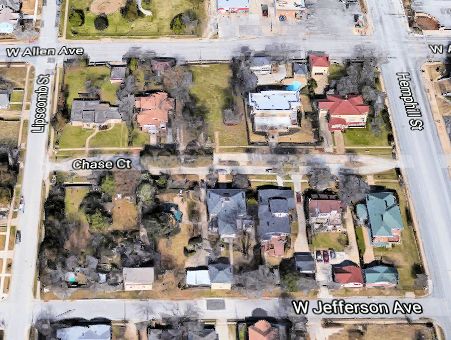 Chase Court is just southwest of the intersection of Hemphill and Allen streets.
Chase Court is just southwest of the intersection of Hemphill and Allen streets.
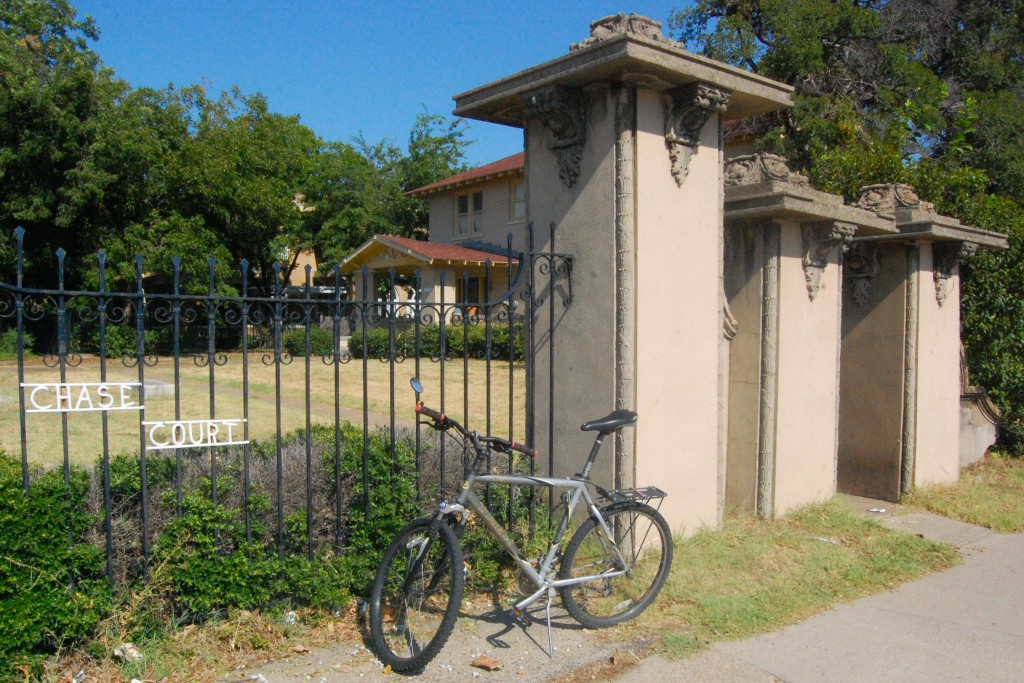
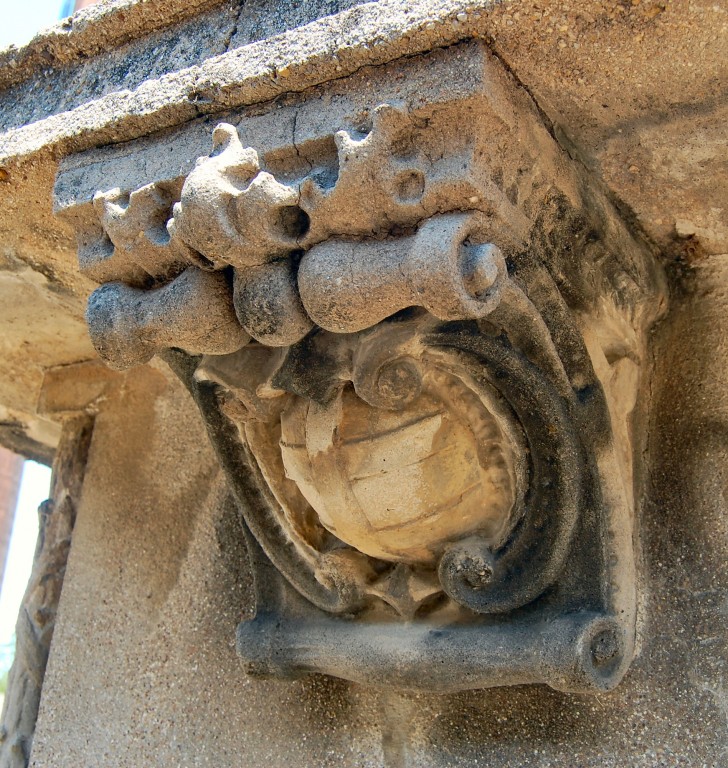 In a sense Chase Court was even more exclusive than Elizabeth Boulevard: Chase Court was enclosed by a wall and was gated; its single street was not a public thoroughfare. Chase Court was a private island of exclusivity floating in the sea of the South Side.
In a sense Chase Court was even more exclusive than Elizabeth Boulevard: Chase Court was enclosed by a wall and was gated; its single street was not a public thoroughfare. Chase Court was a private island of exclusivity floating in the sea of the South Side.
 Chase Court was the namesake legacy of Edwin E. Chase, who was born in Callaway County, Missouri about 1848. As a young man he worked for a brake company in St. Louis. After moving to Texas and investing in cattle in Callahan County, about 1883 he moved to Fort Worth to become first a partner in a loan and investment business and then a banker.
Chase Court was the namesake legacy of Edwin E. Chase, who was born in Callaway County, Missouri about 1848. As a young man he worked for a brake company in St. Louis. After moving to Texas and investing in cattle in Callahan County, about 1883 he moved to Fort Worth to become first a partner in a loan and investment business and then a banker.
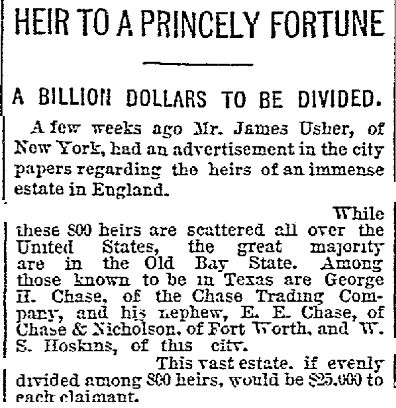
This article in the November 24, 1885 Dallas Morning News indicates that Chase might have inherited some of his wealth. Regardless, in 1887 Chase bought a tract of land south of the city when the South Side was sparsely settled.
 In 1889 Chase built a $50,000 ($1.3 million today) mansion with red granite columns imported from Maine.
In 1889 Chase built a $50,000 ($1.3 million today) mansion with red granite columns imported from Maine.
 Chase’s mansion—Bellevue Hall—was a three-story Victorian showcase of hand-cut limestone. The estate also had a two-story stone barn and a stone stable. Even the windmill was ornate—of stone and brick with windows and a balcony.
Chase’s mansion—Bellevue Hall—was a three-story Victorian showcase of hand-cut limestone. The estate also had a two-story stone barn and a stone stable. Even the windmill was ornate—of stone and brick with windows and a balcony.
Architect of Bellevue Hall was A. N. Dawson, who had partnered with Marshall Sanguinet in the 1880s. Local historian John Shiflet believes Dawson acted as supervising architect, using a house plan drawn by California architect Samuel Newsom, but Dawson used Bellevue Hall in his advertising in the Fort Worth city directory.
Edwin E. Chase raised horses on his estate when he wasn’t working to bring stockyards and packing plants to town, developing real estate, and building the Rosedale streetcar line from downtown to the South Side. The Rosedale line extended from Rosedale Pavilion in the Samuels Avenue area to Fairmount and Ryan Place along Hemphill Street and College Avenue. The line went right past Bellevue Hall (see below).
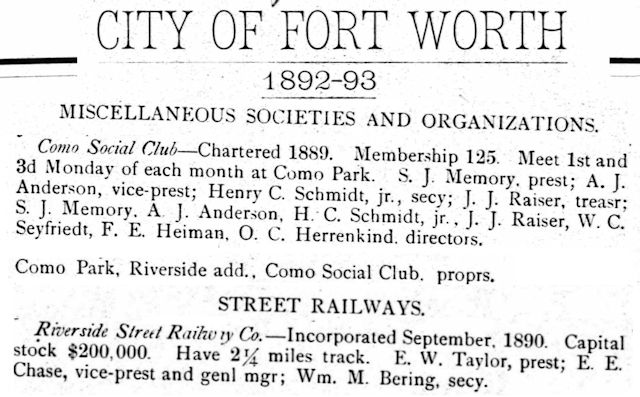
Chase also was vice president of the Riverside Street Railway Company, which operated for two years in the early 1890s. The tracks ran from downtown to Riverside and ended at Como Park, home of the Como Social Club, which hosted an annual Maifest.
 In 1888 the Fort Worth Board of Trade, of which Chase was president, published this curio: a booklet promoting Fort Worth entitled The Capitalist, a parody of Gilbert and Sullivan’s 1885 The Mikado. Chase’s Merchants’ Bank advertised in the booklet.
In 1888 the Fort Worth Board of Trade, of which Chase was president, published this curio: a booklet promoting Fort Worth entitled The Capitalist, a parody of Gilbert and Sullivan’s 1885 The Mikado. Chase’s Merchants’ Bank advertised in the booklet.
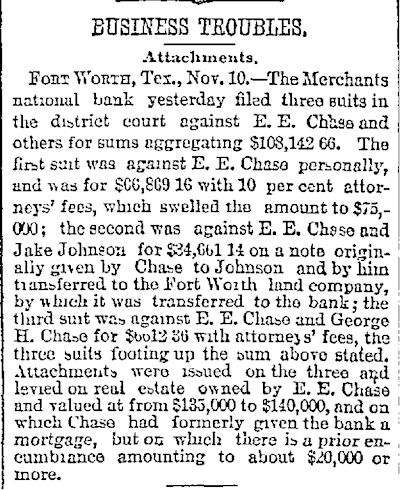 But in 1891 Chase’s bank filed suits against him and others totaling $108,000 ($2.7 million today). The Jake Johnson mentioned in this article, who lived two blocks from Chase, was a gambler-racehorse owner and a proprietor of the Palais Royal Saloon on Main Street. Johnson was the only witness to the Short-Courtright gunfight in 1887. Luke Short worked at the Palais Royal in his later years. Clip is from the November 11 Dallas Morning News.
But in 1891 Chase’s bank filed suits against him and others totaling $108,000 ($2.7 million today). The Jake Johnson mentioned in this article, who lived two blocks from Chase, was a gambler-racehorse owner and a proprietor of the Palais Royal Saloon on Main Street. Johnson was the only witness to the Short-Courtright gunfight in 1887. Luke Short worked at the Palais Royal in his later years. Clip is from the November 11 Dallas Morning News.
 Edwin E. Chase never saw the exclusive subdivision Chase Court. As the 1890s advanced he lost his fortune and fell into debt. On July 24, 1893 the heavily insured Chase mansion was damaged by fire. Clip is from the July 25 Gazette.
Edwin E. Chase never saw the exclusive subdivision Chase Court. As the 1890s advanced he lost his fortune and fell into debt. On July 24, 1893 the heavily insured Chase mansion was damaged by fire. Clip is from the July 25 Gazette.
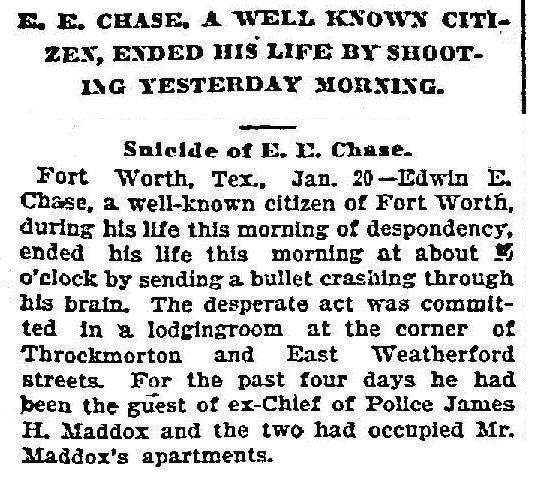 In 1900, despondent because he was losing his sight, Chase committed suicide at age fifty-two. At the time he was the guest of former Police Chief James H. Maddox.
In 1900, despondent because he was losing his sight, Chase committed suicide at age fifty-two. At the time he was the guest of former Police Chief James H. Maddox.
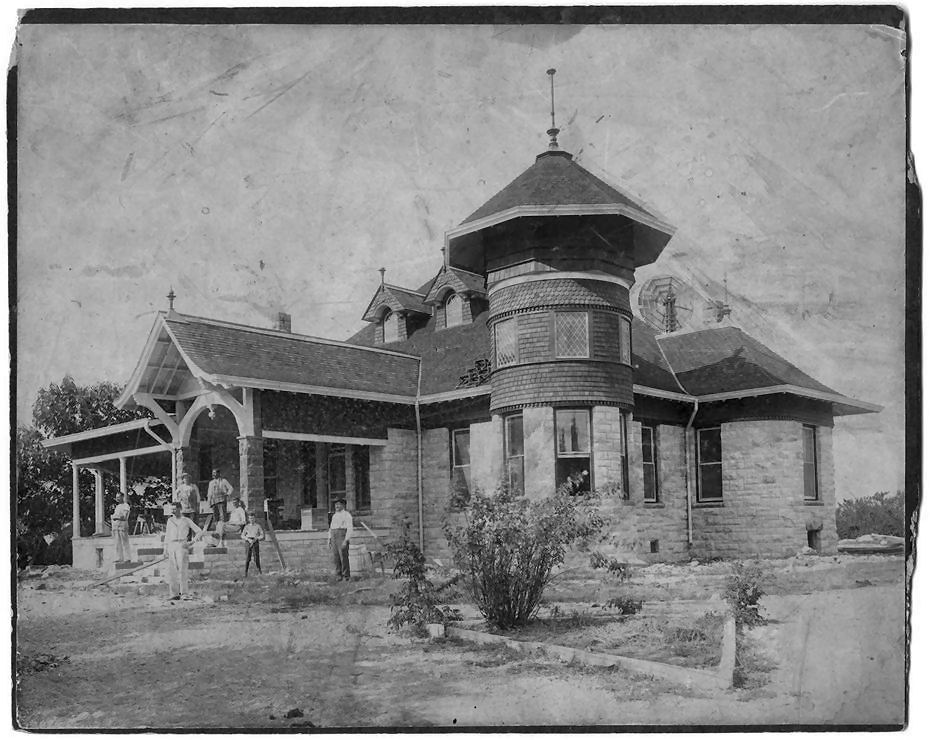 The fire-damaged Chase mansion was rebuilt about 1900 but downsized as an eight-room, two-story stone house. (Photo from University of Texas at Arlington Libraries.)
The fire-damaged Chase mansion was rebuilt about 1900 but downsized as an eight-room, two-story stone house. (Photo from University of Texas at Arlington Libraries.)
 In 1906 a local land syndicate bought the Chase property to develop it as a gated subdivision called “Chase Court.” The Telegram (and later Star-Telegram) announced building plans as lots were sold ($8,000 would be $175,000 today; $10,000 would be $230,000; $20,000 would be $460,000).
In 1906 a local land syndicate bought the Chase property to develop it as a gated subdivision called “Chase Court.” The Telegram (and later Star-Telegram) announced building plans as lots were sold ($8,000 would be $175,000 today; $10,000 would be $230,000; $20,000 would be $460,000).
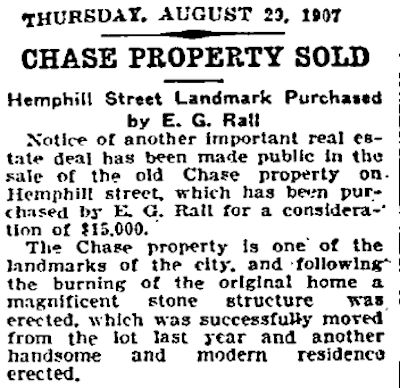 The land syndicate rebuilt the original Chase mansion. In 1907 Elbert George Rall, a partner in the syndicate, bought the rebuilt mansion. Then, after Chase Court was platted, twenty men and one mule raised the rebuilt mansion and moved it ninety feet from lot 3 to lot 4 to rest over a full basement. A crowd gathered to watch.
The land syndicate rebuilt the original Chase mansion. In 1907 Elbert George Rall, a partner in the syndicate, bought the rebuilt mansion. Then, after Chase Court was platted, twenty men and one mule raised the rebuilt mansion and moved it ninety feet from lot 3 to lot 4 to rest over a full basement. A crowd gathered to watch.
 The 1910 Sanborn map shows the rebuilt and relocated Chase mansion as the new subdivision’s first house. The two outbuildings shown probably are E. E. Chase’s original stone barn and stable. (Laurel Street is now Allen Avenue. Cactus Street is now Jefferson Avenue.) (Sketch of E. G. Rall, who was a prominent grain wholesaler, is from Makers of Fort Worth.)
The 1910 Sanborn map shows the rebuilt and relocated Chase mansion as the new subdivision’s first house. The two outbuildings shown probably are E. E. Chase’s original stone barn and stable. (Laurel Street is now Allen Avenue. Cactus Street is now Jefferson Avenue.) (Sketch of E. G. Rall, who was a prominent grain wholesaler, is from Makers of Fort Worth.)
Chase Court quickly became a desirable address, populated by lawyers, judges, doctors, oilmen, and one bare-handed baseball pioneer. Over the years the enclave even became its own dating pool: Sons and daughters found spouses across the street or next door.
 Chase Court residents were often mentioned in the society pages of the newspaper. Especially active were the Rall and Johnson families.
Chase Court residents were often mentioned in the society pages of the newspaper. Especially active were the Rall and Johnson families.
 By 1908 the word court in Chase Court had a different meaning to young lovebirds who perched on Chase Court’s eastern wall to bill and coo (if you’re under forty, look it up).
By 1908 the word court in Chase Court had a different meaning to young lovebirds who perched on Chase Court’s eastern wall to bill and coo (if you’re under forty, look it up).
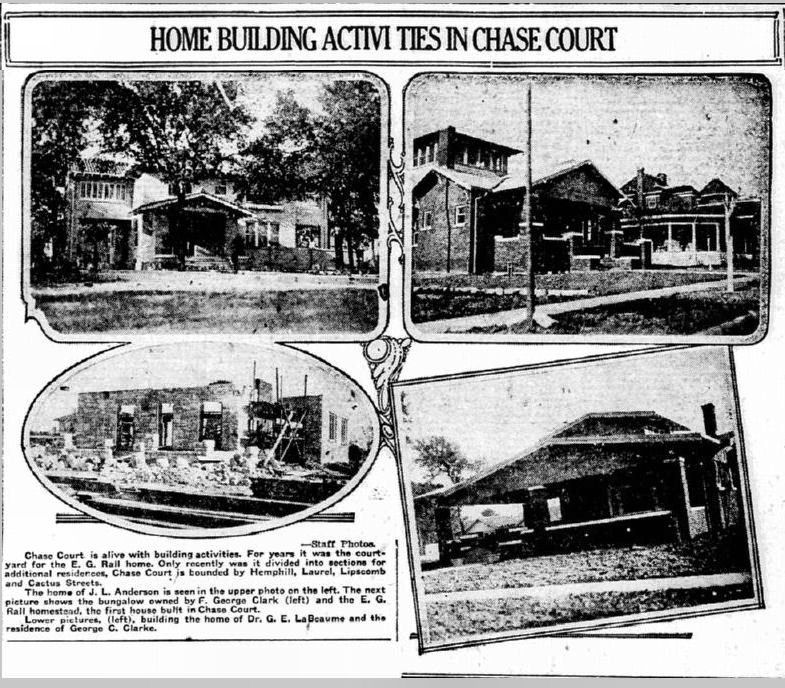 This Star-Telegram report of 1920 shows the Chase Court building boom. Most of the nine surviving houses on Chase Court date from the early 1920s:
This Star-Telegram report of 1920 shows the Chase Court building boom. Most of the nine surviving houses on Chase Court date from the early 1920s:
 1 Chase Court: first house on the right inside the Hemphill Street gates. Built in 1921 for Edward and Hattie Parsons. A later owner was Leo Potishman, who, like Rall, owned a grain company. Potishman established the Leo Potishman Foundation, which has supported many Texas colleges.
1 Chase Court: first house on the right inside the Hemphill Street gates. Built in 1921 for Edward and Hattie Parsons. A later owner was Leo Potishman, who, like Rall, owned a grain company. Potishman established the Leo Potishman Foundation, which has supported many Texas colleges.

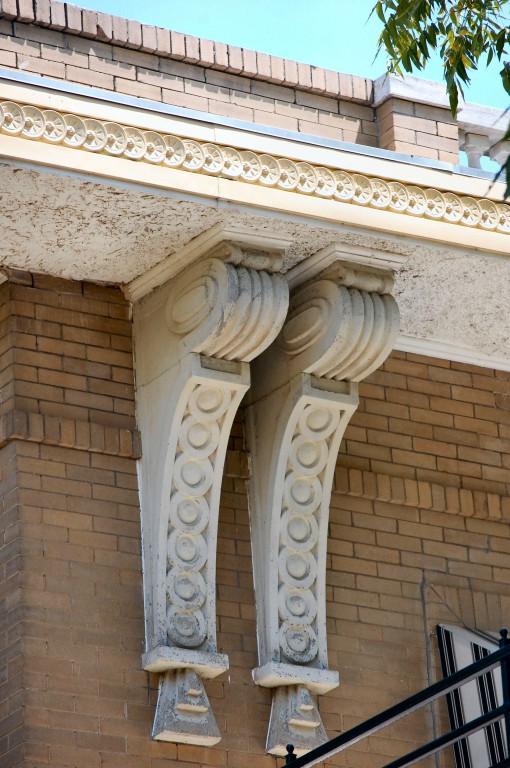 3 Chase Court: the grandest house of those remaining. Built in 1912 for Dr. Clay Johnson, who operated a sanitarium downtown and was chief physician of the Fort Worth & Denver railroad. His wife Alice was sister of Governor Beauford Jester. E. E. Chase’s original house stood about where lot 3 is today.
3 Chase Court: the grandest house of those remaining. Built in 1912 for Dr. Clay Johnson, who operated a sanitarium downtown and was chief physician of the Fort Worth & Denver railroad. His wife Alice was sister of Governor Beauford Jester. E. E. Chase’s original house stood about where lot 3 is today.
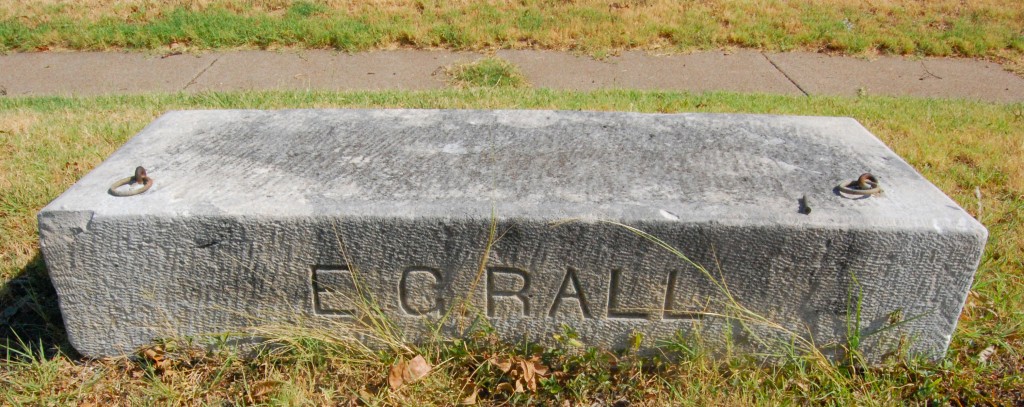 4 Chase Court: After the rebuilt Chase mansion was moved to lot 4, E. G. Rall bought it. In the early 1960s the rebuilt mansion—like the original mansion it had been built from—burned. All that remains of the Chase/Rall residence is a sidewalk, a semicircle of limestone foundation, and a granite carriage step with rings for hitching horses. The carriage step is now in front of the Potishman house at 1 Chase Court.
4 Chase Court: After the rebuilt Chase mansion was moved to lot 4, E. G. Rall bought it. In the early 1960s the rebuilt mansion—like the original mansion it had been built from—burned. All that remains of the Chase/Rall residence is a sidewalk, a semicircle of limestone foundation, and a granite carriage step with rings for hitching horses. The carriage step is now in front of the Potishman house at 1 Chase Court.
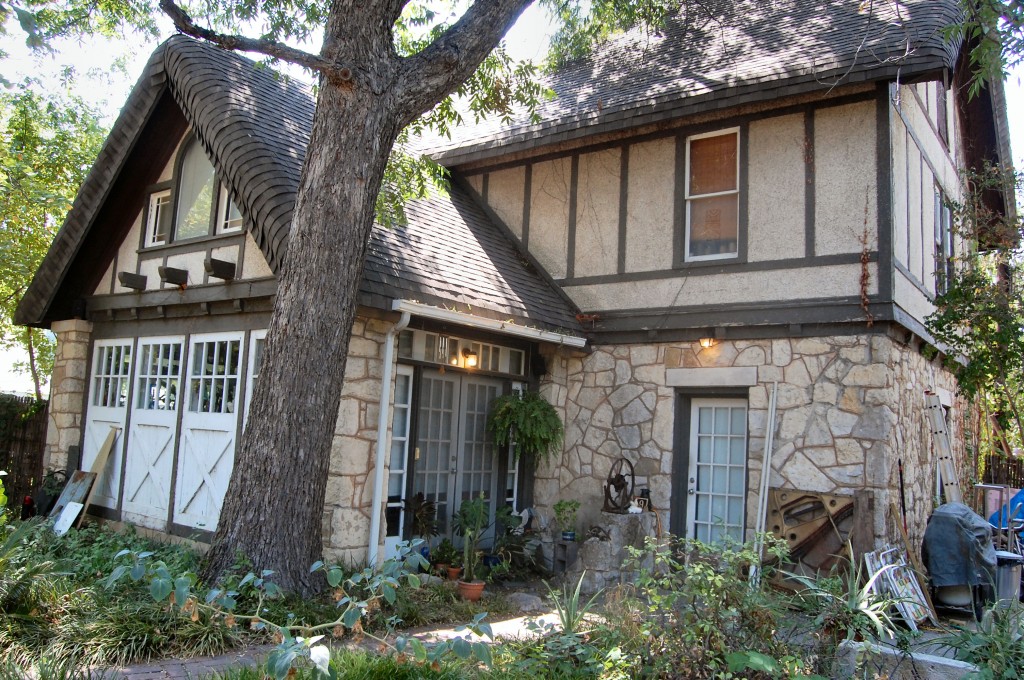 9 Chase Court: the 1920 garage of Dr. Gilbert E. LaBeaume. Dr. LaBeaume’s main house was torn down in 1973. The garage has a “mushroom roof”—the eaves are rolled to simulate thatched roofs of Europe.
9 Chase Court: the 1920 garage of Dr. Gilbert E. LaBeaume. Dr. LaBeaume’s main house was torn down in 1973. The garage has a “mushroom roof”—the eaves are rolled to simulate thatched roofs of Europe.
 11 Chase Court: built by V. S. and Annie Wardlow. Their daughter Verna married Frank Culver, who became a Texas Supreme Court judge. Their daughter Jessie married Dr. Talbot next door at number 10.
11 Chase Court: built by V. S. and Annie Wardlow. Their daughter Verna married Frank Culver, who became a Texas Supreme Court judge. Their daughter Jessie married Dr. Talbot next door at number 10.
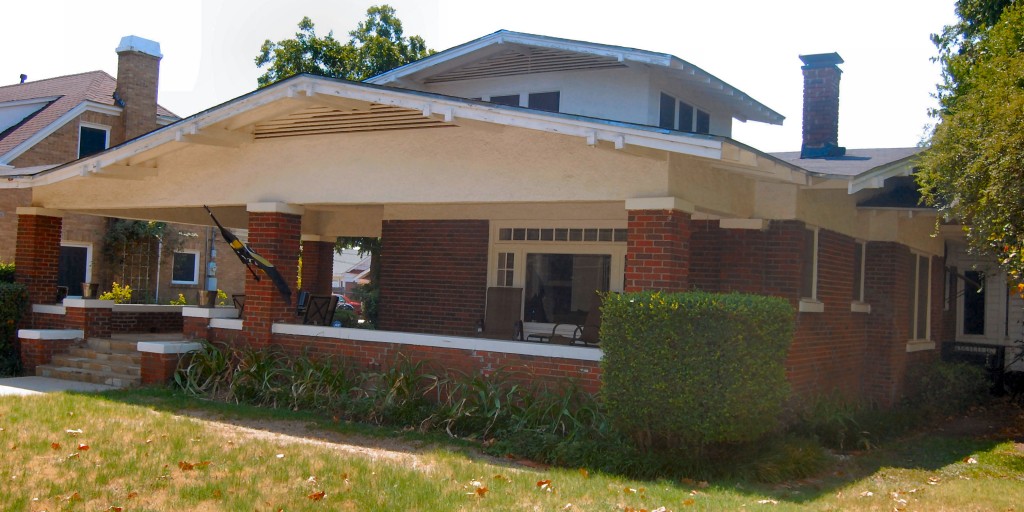 12 Chase Court: can be seen under construction in the 1920 Star-Telegram panel above.
12 Chase Court: can be seen under construction in the 1920 Star-Telegram panel above.
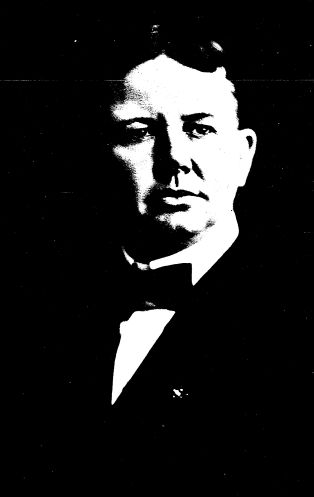
Built for George Carson Clarke (1871-1935), for whom a nearby elementary school is named. Clarke was a South Side developer (Shaw-Clarke, Hubbard Highlands, Hemphill Heights), school board president, and superintendent of city parks.
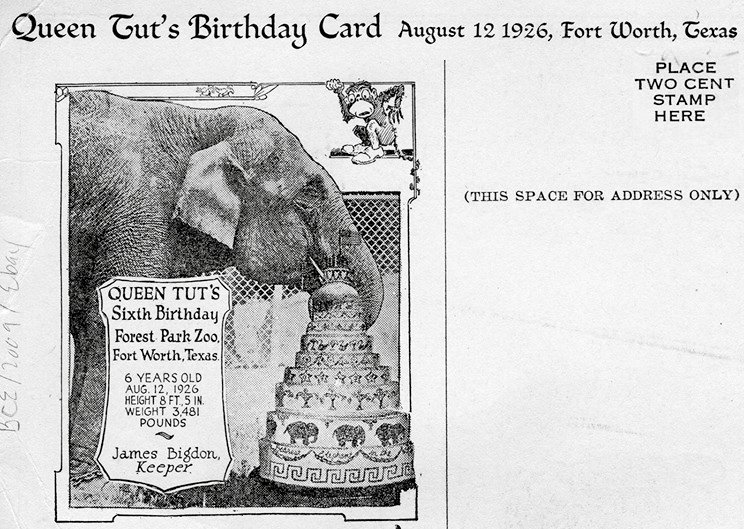 In 1923 Clarke brought to the zoo three-year-old Queen Tut, who remained a favorite of zoo-goers for forty years. (Postcard from Barbara Love Logan.)
In 1923 Clarke brought to the zoo three-year-old Queen Tut, who remained a favorite of zoo-goers for forty years. (Postcard from Barbara Love Logan.)
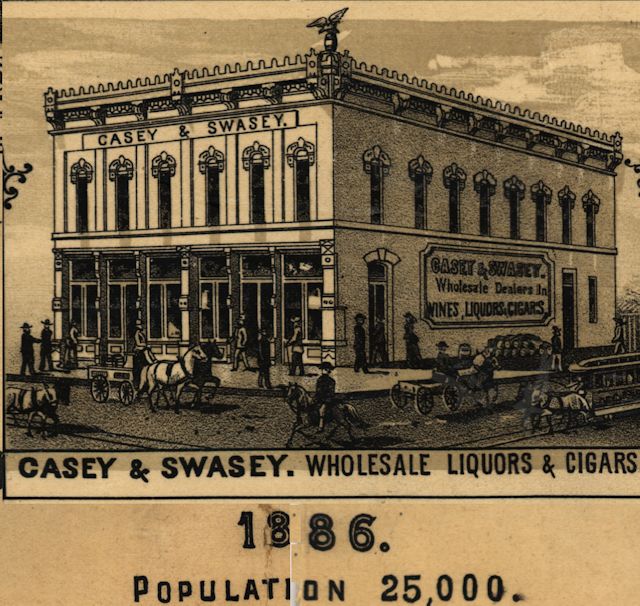 The second owner of the house on lot 12 was Charles James Swasey (1847-1939). After fighting for the Union in the Civil War, in the late 1860s Swasey was an infielder for two early baseball teams: the Chicago Excelsior and the Forest City Club of Rockford, Illinois. Back then fielders did not wear gloves. (Swasey’s teammate A. G. Spalding would help change that.) After Swasey moved to Fort Worth in 1873 he co-founded one of the town’s first wholesale liquor and tobacco companies with Martin Casey. Swasey also was on the first board of directors of B. B. Paddock’s Fort Worth & Rio Grande railroad in 1885.
The second owner of the house on lot 12 was Charles James Swasey (1847-1939). After fighting for the Union in the Civil War, in the late 1860s Swasey was an infielder for two early baseball teams: the Chicago Excelsior and the Forest City Club of Rockford, Illinois. Back then fielders did not wear gloves. (Swasey’s teammate A. G. Spalding would help change that.) After Swasey moved to Fort Worth in 1873 he co-founded one of the town’s first wholesale liquor and tobacco companies with Martin Casey. Swasey also was on the first board of directors of B. B. Paddock’s Fort Worth & Rio Grande railroad in 1885.
The house at number 12 later was a Methodist parsonage. Mrs. Elliott, the lady of the house across the street at number 3, planted a row of cedar trees in front of her house to screen her view of the parsonage because the Reverend Baumfalk was inclined to wear shorts outdoors.
 13 Chase Court: dormers and shutters and beaucoup French doors. Built in 1920, this house is six years older than Queen Elizabeth and Chuck Berry. The boy of the house, Hugh Calhoun Jr., married society belle Estelle Rall of number 4 across the street.
13 Chase Court: dormers and shutters and beaucoup French doors. Built in 1920, this house is six years older than Queen Elizabeth and Chuck Berry. The boy of the house, Hugh Calhoun Jr., married society belle Estelle Rall of number 4 across the street.
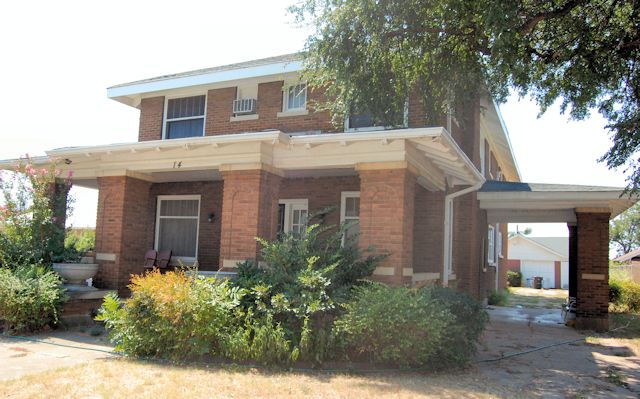
14 Chase Court. Built in 1920. Among early owners was Ernest M. Rogers, a wholesale grain dealer. The building in the rear originally was servants quarters.
 The 1922 city directory offers a snapshot of Chase Court in its prime. The houses on lots 6, 9, and 10 also had servants quarters.
The 1922 city directory offers a snapshot of Chase Court in its prime. The houses on lots 6, 9, and 10 also had servants quarters.
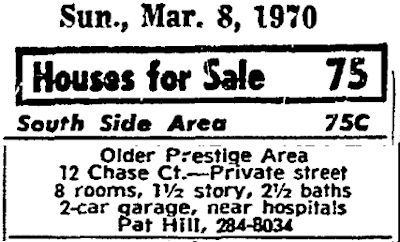 By the 1970s the original residents of Chase Court were gone, and most of the houses were fifty years old. This classified ad for the Clarke/Swasey house on lot 12 refers to Chase Court as an “older prestige area.”
By the 1970s the original residents of Chase Court were gone, and most of the houses were fifty years old. This classified ad for the Clarke/Swasey house on lot 12 refers to Chase Court as an “older prestige area.”
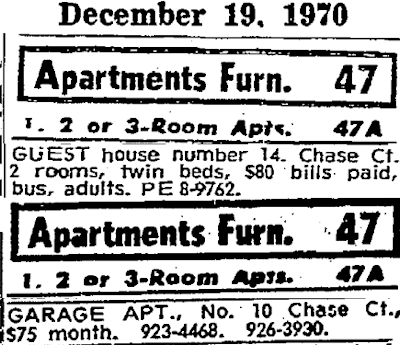 A new generation of owners converted garages and servants quarters and rented them as apartments.
A new generation of owners converted garages and servants quarters and rented them as apartments.
Chase Court, along with the Hemphill corridor, suffered a period of decline in the last part of the twentieth century, but today Chase Court thrives with residents who appreciate the history they are custodians of. After 115 years Chase Court, the little South Side island, still gives us, in its single block, a glimpse of a time when $65,000 would buy a mansion, when young couples courted to the clang of streetcars, and when a row of cedars could shield a modest woman from an immodest Reverend Baumfalk.
(Thanks to Chase Court resident Todd Camp.)






I ran across some information on my grandfather and Chase Court while researching some Ancestry.com files recently. I found a Fort Worth Phone book from 1914. It listed my grandfather as having two residential addresses, besides his office address. The first was 1205 Washington. This is the house my grandparents moved to from their first residence at 810 8th Ave. 2 in the 1912 phone directory. The 2nd residence listed was 2 Chase Court, which I believe would have been next door to 3 Chase Court. 2 Chase Court no longer exists. I haven’t located a 1916 phone directory yet but they moved to 2127 6th Ave about 1916 and lived there for several years. My father was born in that house. I haven’t located any additional information on the 2 Chase Court during the 1914-to-1916-time frame. Usually when I find something new about my grandfather, I have more questions than answers!
I’ve been in one of the homes there . I forget the one, but none the less..it had a bedroom upstairs that within the closet behind the clothes there was a hidden staircase upward.
I grew up in the DeWitt house on Jennings ,2nd house from Allen Ave. Walking to school we loved to look thru fence at houses. I could almost imagine coachmen at the gates. It’s where I wanted to live when I grew up. But times change as do taste. But I was taken with talk the houses had basements, somewhat rare in the south.
I admit I walked into Chase Court for the first time with some trepidation. Would I be arrested for trespass? Great enclave with great history. And I was forty years old before I saw my first Texas basement! Storm cellars, that’s another matter.
I admit I walked into Chase Court for the first time with some trepidation. Would I be arrested for trespass? Great enclave with great history. And I was forty years old before I saw my first Texas basement! Storm cellars, that’s another matter.
Interesting article. Dr. Johnson’s house was probably the very first project my grandfather was involved with when he moved to Fort Worth in Jan. of 1912 and joined with Waller and Field. In Dec of 1911, Dr. Johnson was instrumental in setting up an interview between my grandfather and e. Stanley Field of Waller and Field Architects. At the time, Field was quite unhappy with Waller and wanted him out of the firm. My grandfather sent details of the interview to Dr. Johnson after the interview describing Stanley’s dislike of Waller. My grandfather probably started with Waller and Field around the 1st of Feb, 1912, after his marriage to Dr. Johnson’s niece from Corsican. I believe he was the main design architect of the house based on several other houses he designed in the next several years, a couple of letters he wrote to possible clients a few years later taking credit for the Johnson home, and the Johnson house was one of the houses that my grandmother told me he designed (several times!). Waller apparently left the firm in the Spring of 1912 and the firm became Field and Clarkson Architects.
What a wonderful article! As a child, during the 1960’s, my family attended Central Methodist Church on Lipscomb. I remember driving past, the then very rundown, Chase Court and catching glimpses of an opulent and mysterious past. There was a fire station next to the church and an old drug store behind it on Hemphill. At one time, my big brother worked at the soda fountain in that drug store. We would walk over after church sometimes for a Coke float. I remember walking along the Chase Court wall many times and being bombarded with the feelings and longings of long ago. It was a magical place during a wonderous time in my young life.
Thanks, Linda. Chase Court has a touch of the Gothic from outside, but it’s fascinating on the inside.
very nice article Todd Camp!
Marvelous and sprawling, as promised.
Thanks, Kara. I learned enough about Chase Court to qualify to be an insufferable bore on the topic.